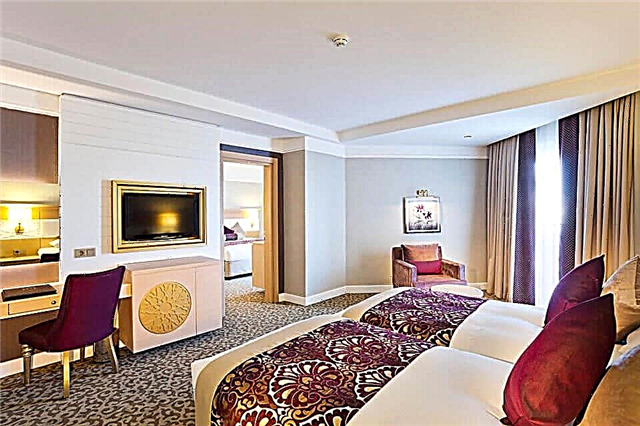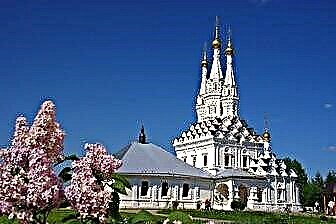Mystical legends are not born from scratch - they always have a real basis: objects, natural phenomena, significant events. The most mysterious, gloomy places and events have a truthful prosaic explanation that reveals the mystery of their origin. An example of such a place is the ancient Whitby Abbey, located on the eastern British coast, in Yorkshire. Whitby Abbey is otherwise called "the monastery of stone snakes" for the petrified spiral-shaped shells in its surroundings, reminiscent of frozen snake "rings". As the legend says, these shells are snakes, once turned into stone statues by Saint Hilda in order to rid the inhabitants of dangerous reptiles. And until now, stones of this shape, which are often found in North Yorkshire, are called "stone snakes" by the locals.
Description of Whitby Abbey

What is this place now shrouded in a mystical web of romantic legends and dark beliefs? On the heights of East Cliff near Whitby, surrounded by verdant fields and meadows, the ghostly ruins of a once majestic structure rise up. The narrow Gothic window openings, the pointed domes of the surviving towers are witnesses of deep antiquity. In the evening hours, when the last reflections of the crimson sunset are extinguished, the monastery ruins seem to be black giants. Silently they listen to the symphonies of the wind walking through the empty halls, the numerous monuments installed at the local cemetery, where the inhabitants of the monastery were buried. Some of the gravestones are dated from 667 to 865 years.

History of Whitby Abbey
The legendary monastery (657) was organized and built at the behest of King Oswiu, who defeated the ruler of Mercia. On the eve of the battle, the king vowed before the Christian church to build a monastery on the conquered land. This is how the famous Whitby Abbey arose, and its first abbess was the nun Hilda, who after her death was given the status of "saint" for her services in the development of the abbey. At first, both men and women lived in the abbey, and later it (the abbey) became a men's monastery. Gradually, the holy monastery turned into a popular youth education center. It is known that a well-known representative of early British poetry, Cadmon, was brought up and studied within its walls. Here the descendants of the Deir royal family found their last refuge, important church cathedrals were held, including the fateful cathedral of 664, during which the Roman Church gained an advantage over the representatives of the Celtic Church.

The proceeds from the city fairs, held annually on the birthday of St. Hilda, went to the treasury of the abbey, and it flourished again until in the 15th century. Whitby was not ruined by the Norwegians. The abbey suffered the sad fate of oblivion during the reign of Henry VIII of England. Great damage to buildings, turned into ruins, was inflicted during shelling by German cruisers in the First World War (1915).

Mystical legends about Whitby Abbey
The majestic ruins of an ancient monastery over a centuries-old history have inspired many legends and beliefs that have survived to this day, exciting the imagination and hearts of local residents and curious tourists. Despite the "electronic" age, the myth of the transformation of snakes by St. Hilda into stones continues to live. Many claim that they have repeatedly seen in the gaps of the windows a moving silhouette of a girl who once broke her vow of celibacy. Once she saw a beautiful knight, the nun fell in love with him at first sight with all the passion of a woman yearning for love for a man. She was severely punished for carnal sin: she was immured alive in the wall of one of the tombs.

One of the legends tells of the bells removed from the belfry of the abbey, sunk in the sea, but still ringing from the seabed. In the 18th century, under the pretext of dispelling rumors of spontaneously ringing bells remaining in the abbey, and the appearing ghost of Saint Hilda, the authorities ordered them (the bells) to be removed and taken by ship to be melted down. Having sailed from the coast for a short distance, the ship sank for some unknown reason, providing food for new myths about the underwater chime of bells. There is a belief about the collapse of the main high (30 m) tower of the abbey, which collapsed suddenly, for no apparent reason. As local residents assured, on the eve of the collapse for several days, they allegedly observed the ghosts of Whitby residents who had died long ago, circling around the tower.
Legend of Count Dracula

The mystical Abbey of Whitby is also associated with the name of the notorious Count Dracula, who became the hero of the novel of the same name by Bram Stoker, who was inspired by the expressive spectacle of the monastery ruins and made them the place where Dracula turned into a vile dog. The real prototype of this hero - the Romanian Count Vlad Tepes (Kol) became famous for his infinite cruelty towards his enemies, who, on his order, were impaled. The sight of the bleeding victims caused satisfaction in the inhuman soul of Dracula, and, probably, that is why he was called by the people a vampire.

The image of Lucy in the novel, who became a vampire, also did not arise from scratch. His prototype was a real woman aristocrat, about whose cruel sadism there were many rumors. She personally executed her maids, enjoying the sight of the pouring blood. The villainous image of Dracula became a fertile basis for the creation of various works of art: novels, performances, operas, films. Many Eastern Europeans believe that it was in one of the castles of their country that this vampire count once lived. Not without its Dracula and Whitby Abbey, "glorified" in Stoker's novel, which has become a "horror classic". Residents of the local neighborhood are firmly convinced that the former monastery is Dracula's castle.
The modern reality of Whitby Abbey

Today, a small British town (13 thousand inhabitants), despite its insignificant size, has become a major tourist attraction, attracting a huge number of tourists from different countries. Fans of everything mystical, lovers of extreme hobbies, artists, poets, writers, filmmakers, etc. come here. Ancient castles, Dalby forest, Mallan Spout waterfall and other attractions are of interest to everyone, even very sophisticated travelers. Here you are imbued with the atmosphere of medieval England, a powerful ruler.
The main attractive symbol of these places is the ruins of Whitby Abbey, which amaze the imagination not only with their Gothic appearance, but also with a train of extraordinary legends associated with them, and the dramatic history of the former monastery. In recent years, luxury modern hotels and guest houses of various comfort levels from 3 stars and higher have appeared in the city and its environs. Most of them are located in picturesque places with good ecology, the interior arrangement is made in impeccable English style.
Beautiful landscapes, the proximity of unique attractions make your stay in Whitby rich and rich in impressions, give rise to romantic feelings in the soul and inspire the creation of works of art.
How to get to Whitby
The most difficult thing in organizing a trip to England for Russian tourists is to get a Schengen visa, but otherwise there are no problems. If you are a Schengen holder, there are no obstacles to arriving in London. There are plenty of flights from Moscow airports, 4 hours - and you are in London. From there, trains go to Yorkshire. In a 2-hour journey, you arrive in York, from which you can get to Whitby by a comfortable bus in 1.5 hours.If you arrive in Whitby in the evening, easily settle for the night at one of the city's many hotels before heading to the abbey in the morning.
It is open for visits all year round according to a specific schedule. March-September - from 10.00 to 18.00; October-November - 10.00-17.00, in other months the monastery is open on weekends - Saturdays and Sundays, from 10.00 to 16.00. The Dracula Museum accepts visitors in the summer months, from 10.00 to 16.00; in the winter months - only on weekends, from 10.00 to 16.00.











